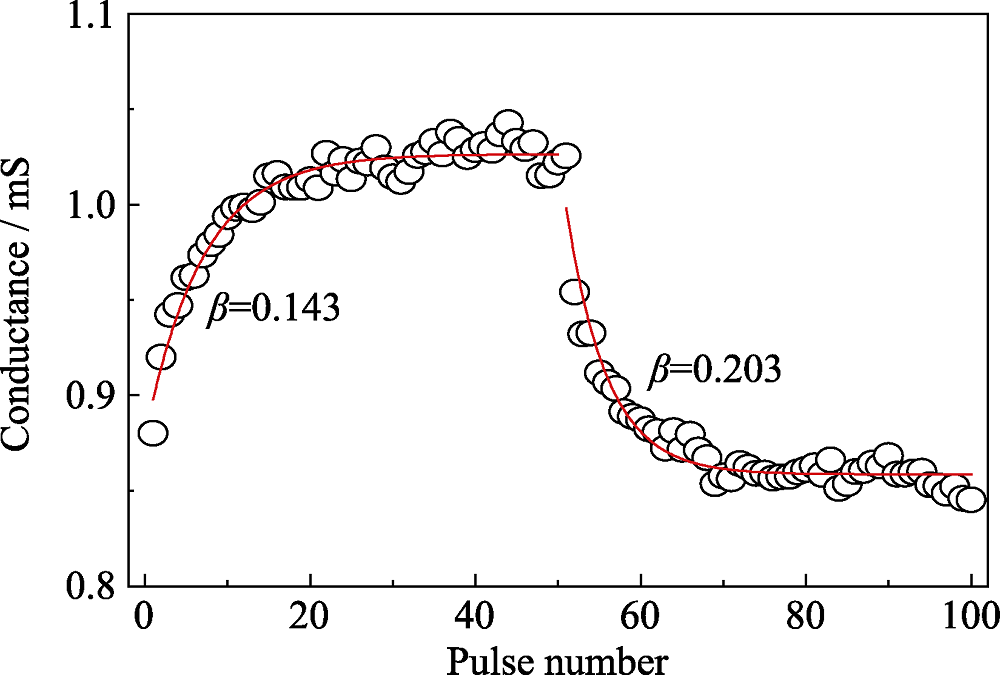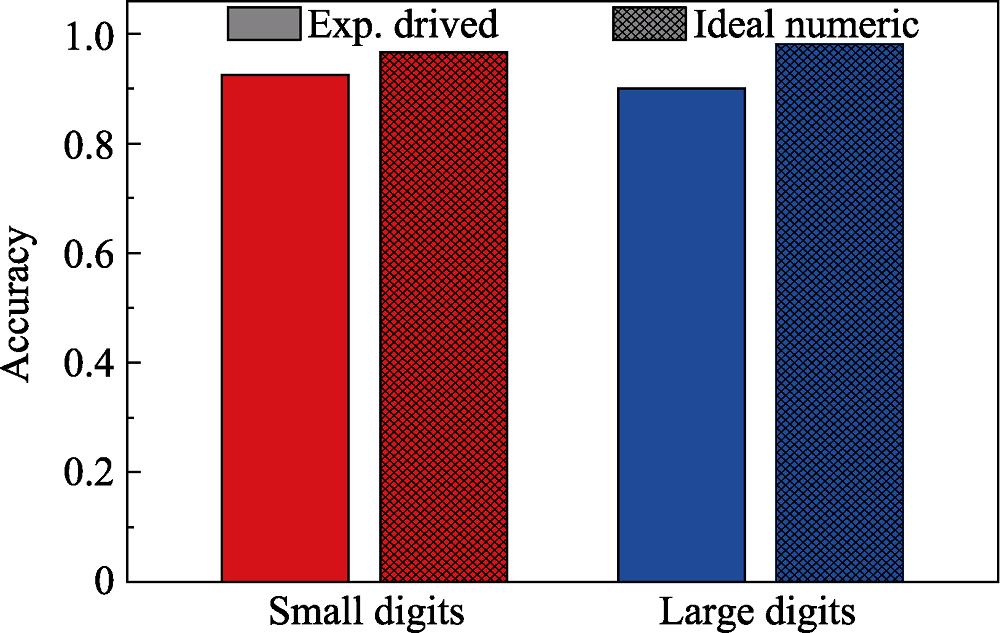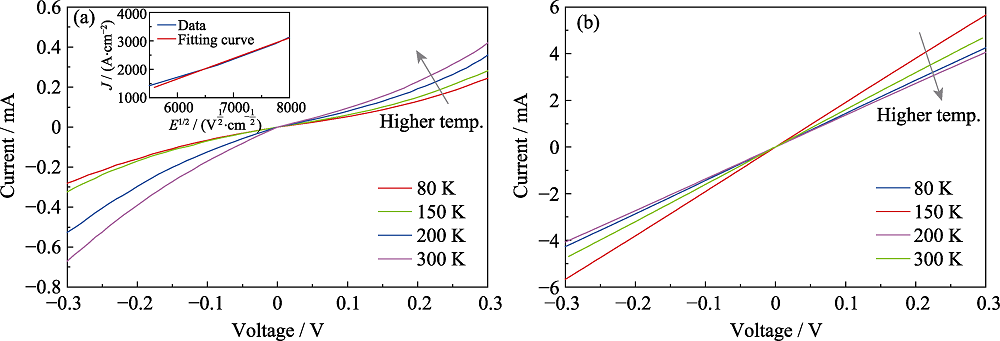无机材料学报 ›› 2022, Vol. 37 ›› Issue (7): 795-801.DOI: 10.15541/jim20210658 CSTR: 32189.14.10.15541/jim20210658
何慧凯1( ), 杨蕊2,3(
), 杨蕊2,3( ), 夏剑3,4, 王廷泽3,4, 董德泉3,4, 缪向水2,3
), 夏剑3,4, 王廷泽3,4, 董德泉3,4, 缪向水2,3
收稿日期:2021-10-25
修回日期:2021-12-14
出版日期:2022-07-20
网络出版日期:2022-01-06
通讯作者:
杨 蕊, 教授. E-mail: yangrui@hust.edu.cn作者简介:何慧凯(1992-), 博士. E-mail: hehk@hust.edu.cn
HE Huikai1( ), YANG Rui2,3(
), YANG Rui2,3( ), XIA Jian3,4, WANG Tingze3,4, DONG Dequan3,4, MIAO Xiangshui2,3
), XIA Jian3,4, WANG Tingze3,4, DONG Dequan3,4, MIAO Xiangshui2,3
Received:2021-10-25
Revised:2021-12-14
Published:2022-07-20
Online:2022-01-06
Contact:
YANG Rui, professor. E-mail: yangrui@hust.edu.cnAbout author:HE Huikai (1992-), PhD. E-mail: hehk@hust.edu.cn
Supported by:摘要:
二维过渡金属硫化合物是构建纳米电子器件的理想材料, 基于该材料体系开发用于信息存储和神经形态计算的忆阻器, 受到了学术界的广泛关注。受制于低成品率和低均一性问题, 二维过渡金属硫化合物忆阻器阵列鲜见报道。本研究采用化学气相沉积得到厘米级二维碲化钼薄膜, 并通过湿法转移和剥离工艺制备得到碲化钼忆阻器件。该碲化钼器件表现出优异的保持性(保持时间>500 s)、快速的阻变(SET时间~60 ns, RESET时间~280 ns)和较好的循环寿命(阻变2000圈后仍可正常工作)。该器件具有高成品率(96%)、低阻变循环间差异性(SET过程为6.6%, RESET过程为5.2%)和低器件间差异性(SET过程为19.9%, RESET过程为15.6%)。本工作成功制备出基于MoTe2的3×3忆阻器阵列。在此基础上, 将研制的MoTe2器件用于手写体识别, 实现了91.3%的识别率。最后, 通过对MoTe2器件高低阻态的电子输运机制进行拟合分析, 揭示了该器件阻变源于类金属导电细丝的通断过程。本项工作表明大尺寸二维过渡金属硫化合物在未来神经形态计算中具有巨大的应用潜力。
中图分类号:
何慧凯, 杨蕊, 夏剑, 王廷泽, 董德泉, 缪向水. 高均一性二维碲化钼忆阻器阵列及其神经形态计算应用[J]. 无机材料学报, 2022, 37(7): 795-801.
HE Huikai, YANG Rui, XIA Jian, WANG Tingze, DONG Dequan, MIAO Xiangshui. High-uniformity Memristor Arrays Based on Two-dimensional MoTe2 for Neuromorphic Computing[J]. Journal of Inorganic Materials, 2022, 37(7): 795-801.

Fig. 1 Characterization of MoTe2 film and electrical measurement of Au/Ti/MoTe2/Au/Ti device (a) Photo of the centimeter-scale MoTe2 film; (b) Raman spectrum of the MoTe2 film; (c) Optical image of the prepared memristive devices with the structure of Au/Ti/MoTe2/Au/Ti; (d) Optical image of a 3×3 memristor array

Fig. 2 Stable bipolar resistive switching behavior and retention characteristics of the MoTe2 device (a) 20 cycles of I-V curves with a compliance current of 3 mA; (b) Retention characteristics of the HRS and the LRS read at 0.1 V

Fig. 3 Fast switching and good endurance of the MoTe2 device (a) SET speed under the pulse with the amplitude 1.3 V; (b) RESET speed of the MoTe2 device under the pulse with the amplitude of -1.0 V; (c) Over 2000 switching cycles obtained by applying SET pulse of 1.7 V/700 ns and RESET pulse of -1.2 V/7 μs Colorful figures are available on website

Fig. S6 I-V curves of 24 Au/Ti/MoTe2/Au/Ti devices All devices show stable resistive switching with low cycle-to-cycle and device-to-device variability

Fig. S8 Estimation of the array size for the prepared CVD-MoTe2 device (a) Sneak current path at read in a square crossbar array where all bits except the selected one are at LRS, and the equivalent circuit can be represented by three resistors (region 1, region 2 and region 3); (b) Dependence of the read margin on the crossbar line number for both 1R and 1T1R schemes

Fig. 5 Stable resistive switching of the MoTe2 array device after electroforming process (a) Electroforming process of the MoTe2 array device; (b) 20 cycles I-V curves of the MoTe2 array device with a compliance current of 5 Ma

Fig. 6 Potentiation and depression processes of the present device Circles are experimental results, red lines are fitting results with a phenomenological model $G=a+c{{e}^{-\beta N}}$

Fig. 7 Recognition accuracy for small and large handwritten digit images with experimental devices and ideal numeric Colorful figures are available on website

Fig. 8 Mechanism analysis of the memristive behavior in the MoTe2 device (a) I-V characteristics at HRS under different temperatures, with current increasing as the temperature increases Fitted data using the Schottky emission model for HRS is shown in the inset; (b) I-V characteristics at LRS at different temperatures, with current decreasing as the temperature increase, indicating a metallic characteristic
| Scheme | | | | N |
|---|---|---|---|---|
| 1R | 150 | 1500 | 150 | 4 |
| 1S1R | 350 | 1700 | 1.25×105 | 870 |
Table 1 Key resistance values and the corresponding maximum number of word lines/bit lines (N) with read margin >10%
| Scheme | | | | N |
|---|---|---|---|---|
| 1R | 150 | 1500 | 150 | 4 |
| 1S1R | 350 | 1700 | 1.25×105 | 870 |
| [1] |
SILVER D, SCHRITTWIESER J, SIMONYAN K, et al. Mastering the game of Go without human knowledge. Nature, 2017, 550(7676): 354-359.
DOI URL |
| [2] |
CHUA L O. Memristor-the missing circuit element. IEEE Transactions. Circuit Theory, 1971, 18(5): 507-519.
DOI URL |
| [3] | STRUKOV D B, SNIDER G S, STEWART D R, et al. The missing memristor found. Nature, 2009, 459(7250): 1154. |
| [4] | YANG R, HUANG H M, GUO X. Memristive synapses and neurons for bio-inspired computing. Advanced Electronic Materials, 2019, 5(9): 1900287. |
| [5] | HE H K, YANG R, ZHOU W, et al. Photonic potentiation and electric habituation in ultrathin memristive synapses based on monolayer MoS2. Small, 2018, 14(15): 1800079. |
| [6] | YANG R, HUANG H M, HONG Q H, et al. Synaptic suppression triplet-STDP learning rule realized in second-order memristors. Advanced Functional Materials, 2018, 28(5): 1704455. |
| [7] |
HE H K, YANG R, HUANG H M, et al. Multi-gate memristive synapses realized with the lateral heterostructure of 2D WSe2 and WO3. Nanoscale, 2019, 12(1): 380-387.
DOI URL |
| [8] | HUANG H M, YANG R, TAN Z H, et al. Quasi-hodgkin-huxley neurons with leaky integrate-and-fire functions physically realized with memristive devices. Advanced Materials, 2019, 31(3): 1803849. |
| [9] |
XU M, LIANG T, SHI M, et al. Graphene-like two-dimensional materials. Chemical Review, 2013, 113(5): 3766-3798.
DOI URL |
| [10] |
FIORI G, BONACCORSO F, IANNACCONE G, et al. Electronics based on two-dimensional materials. Nature Nanotechnology, 2014, 9(10): 768-779.
DOI URL |
| [11] | CHANG C, CHEN W, CHEN Y, et al. Recent progress on two-dimensional materials. Acta Physico-Chimica Sinica, 2021, 37(12): 2108017. |
| [12] | WANG C Y, WANG C, MENG F, et al. 2D layered materials for memristive and neuromorphic applications. Advanced Electronic Materials, 2020, 6(2): 1901107. |
| [13] |
WANG M, CAI S, PAN C, et al. Robust memristors based on layered two-dimensional materials. Nature Electronics, 2018, 1(3): 203.
DOI URL |
| [14] |
SHI Y, LIANG X, YUAN B, et al. Electronic synapses made of layered two-dimensional materials. Nature Electronics, 2018, 1(8): 458-465.
DOI URL |
| [15] |
HE H K, YANG F F, YANG R. Flexible full two-dimensional memristive synapses of graphene/WSe2xOy/graphene. Physical Chemistry Chemical Physics, 2020, 22(36): 20658.
DOI URL |
| [16] |
YAMAMOTO M, WANG S T, NI M, et al. Strong enhancement of raman scattering from a bulk-inactive vibrational mode in few-layer MoTe2. ACS Nano, 2014, 8(4): 3895-3903.
DOI URL |
| [17] | GUO H, TENG Y, YAMAMOTO M, et al. Double resonance Raman modes in mono- and few-layer MoTe2. Physical Review B, 2015, 91(20): 205415-205415. |
| [18] |
ADAM G C, HOSKINS B D, PREZIOSO M, et al. 3-D memristor crossbars for analog and neuromorphic computing applications. IEEE Transactions on Electron Devices, 2016, 64(99): 312-318.
DOI URL |
| [19] |
SANGWAN V K, LEE H S, BERGERON H, et al. Multi-terminal memtransistors from polycrystalline monolayer molybdenum disulfide. Nature, 2018, 554(7693): 500-504.
DOI URL |
| [20] |
CHEN S, MAHMOODI M R, SHI Y, et al. Wafer-scale integration of two-dimensional materials in high-density memristive crossbar arrays for artificial neural networks. Nature Electronics, 2020, 3(10): 638-645.
DOI URL |
| [21] |
WANG Z, YIN M, TENG Z, et al. Engineering incremental resistive switching in TaOx based memristors for brain-inspired computing. Nanoscale, 2016, 8(29): 14015-14022.
DOI URL |
| [22] |
BURGT Y, LUBBERMAN E, FULLER E J, et al. A non-volatile organic electrochemical device as a low-voltage artificial synapse for neuromorphic computing. Nature Materials, 2017, 16(4): 414-418.
DOI URL |
| [23] | CrossSim platform. https://cross-sim.sandia.gov/ (accessed: July 2019). |
| [24] | ALAMGIR Z, BECKMANN K, HOLT J, et al. Pulse width and height modulation for multi-level resistance in bi-layer TaOx based RRAM. Applied Physics Letters, 2017, 111(6): 063111. |
| [25] |
WANG Y, XIAO J, ZHU H, et al. Structural phase transition in monolayer MoTe2 driven by electrostatic doping. Nature, 2017, 550(7677): 487.
DOI URL |
| [26] |
SHI Y, LIANG X, YUAN B, et al. Electronic synapses made of layered two-dimensional materials. Nature Electronics, 2018, 1(8): 458-465.
DOI URL |
| [1] | 李宗晓, 胡令祥, 王敬蕊, 诸葛飞. 氧化物神经元器件及其神经网络应用[J]. 无机材料学报, 2024, 39(4): 345-358. |
| [2] | 万胡杰, 肖旭. MXenes及其复合物的太赫兹电磁屏蔽与吸收[J]. 无机材料学报, 2024, 39(2): 129-144. |
| [3] | 游钧淇, 李策, 杨栋梁, 孙林锋. 氧化物双介质层忆阻器的设计及应用[J]. 无机材料学报, 2023, 38(4): 387-398. |
| [4] | 田雨, 朱小健, 孙翠, 叶晓羽, 刘慧媛, 李润伟. 本征可拉伸阈值型忆阻器及其神经元仿生特性[J]. 无机材料学报, 2023, 38(4): 413-420. |
| [5] | 诸葛霞, 朱仁祥, 王建民, 王敬蕊, 诸葛飞. 面向类脑计算的氧化物忆阻器[J]. 无机材料学报, 2023, 38(10): 1149-1162. |
| [6] | 李涛, 曹鹏飞, 胡力涛, 夏勇, 陈一, 刘跃军, 孙翱魁. NH4+扩层MoS2的制备及其储锌性能研究[J]. 无机材料学报, 2023, 38(1): 79-86. |
| [7] | 孙炼, 顾全超, 杨雅萍, 王洪磊, 余金山, 周新贵. 二维过渡金属硫属化合物氧还原反应催化剂的研究进展[J]. 无机材料学报, 2022, 37(7): 697-709. |
| [8] | 袁罡, 马新国, 贺华, 邓水全, 段汪洋, 程正旺, 邹维. 平面应变对二维单层MoSi2N4能带结构和光电性质的影响[J]. 无机材料学报, 2022, 37(5): 527-533. |
| [9] | 雷伟岩, 王岳, 武世然, 石东新, 沈毅, 李锋锋. VA族单元素二维纳米材料在生物医用领域的研究进展[J]. 无机材料学报, 2022, 37(11): 1181-1191. |
| [10] | 夏芳芳, 王发坤, 胡海龙, 许翔, 李阳, 翟天佑. 二次谐波在二维材料结构表征中的应用[J]. 无机材料学报, 2021, 36(10): 1022-1030. |
| [11] | 杨浏鑫,罗文华,汪长安,徐晨. 新型无机二维材料在气体分离膜领域的研究进展[J]. 无机材料学报, 2020, 35(9): 959-971. |
| [12] | 李能,孔周舟,陈星竹,杨雨菲. 新型二维材料光催化与电催化研究进展[J]. 无机材料学报, 2020, 35(7): 735-747. |
| [13] | 郑云,陈亦琳,高碧芬,林碧洲. 磷烯光催化分解水研究进展[J]. 无机材料学报, 2020, 35(6): 647-653. |
| [14] | 山巍,傅正钱,张发强,马名生,刘志甫,李永祥. SnS2纳米片的制备及其对NO2气体的检测[J]. 无机材料学报, 2020, 35(4): 497-504. |
| [15] | 高天, 肖庆林, 许晨阳, 王学斌. 发泡法制备二维材料泡沫体的进展[J]. 无机材料学报, 2020, 35(12): 1315-1326. |
| 阅读次数 | ||||||
|
全文 |
|
|||||
|
摘要 |
|
|||||